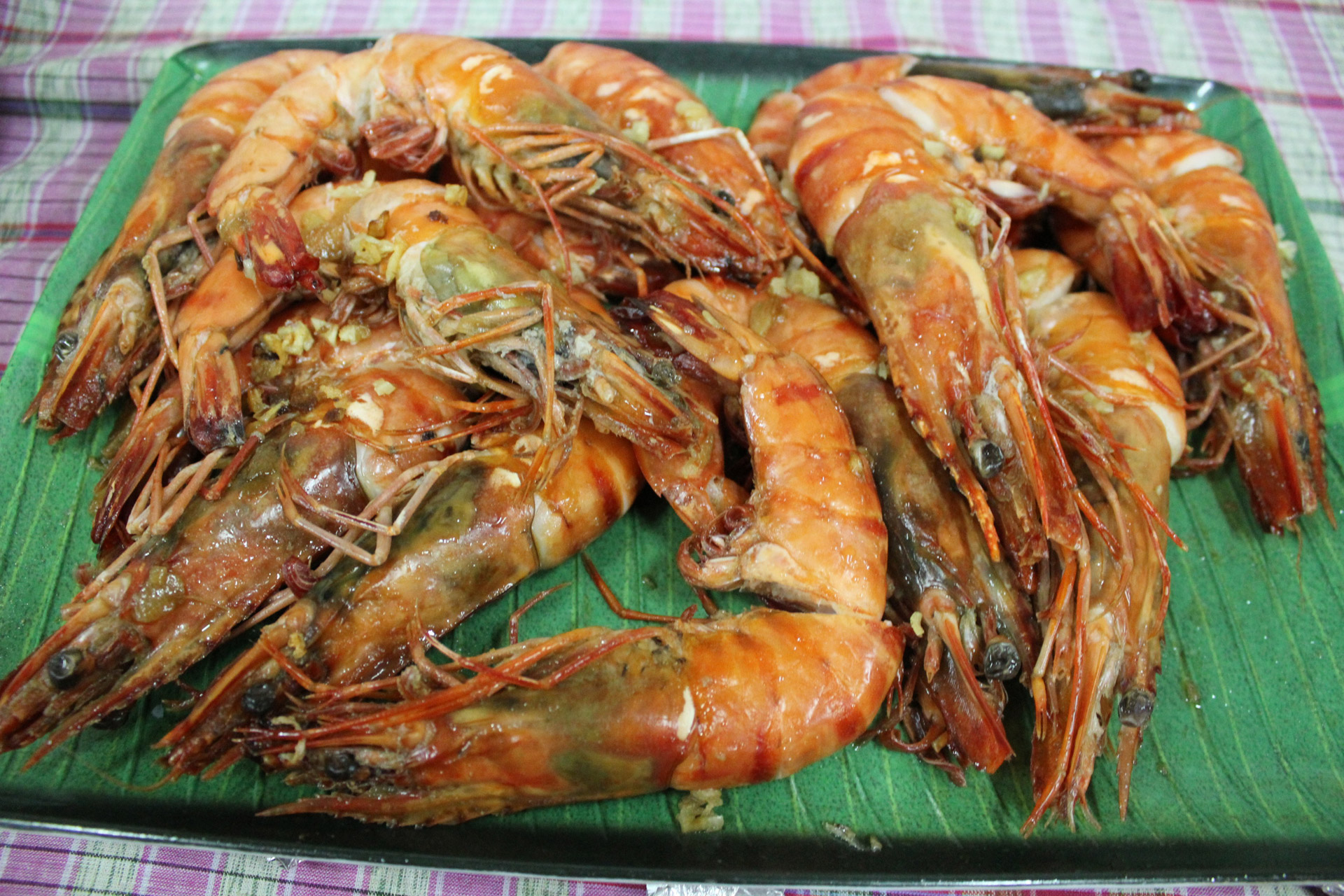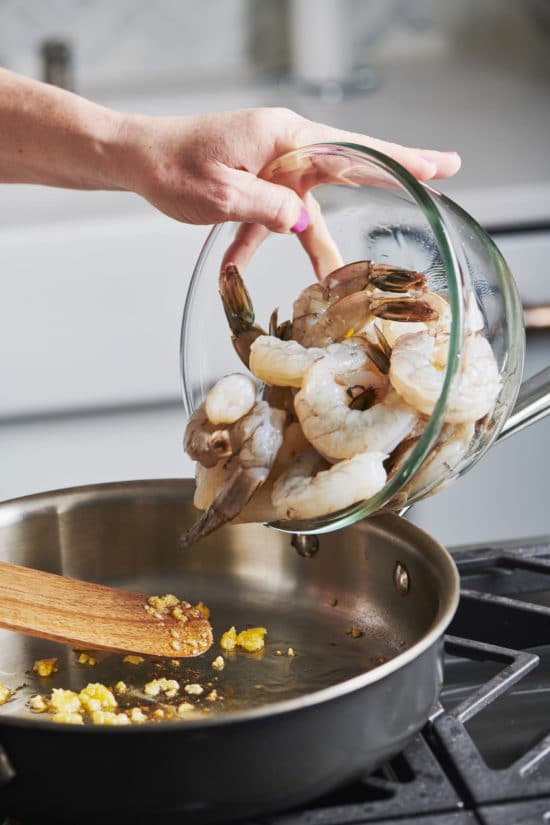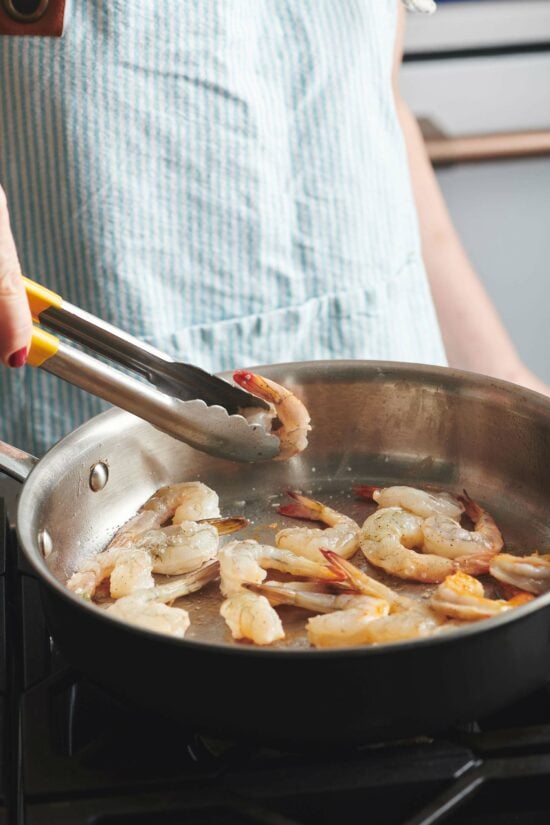Simple sautéed shrimp can be a main course on their own. They are also wonderful added into grain salads, stir fries, and more.
Shrimp are exceedingly popular for good reason. Delicately flavored, slightly sweet, a bit salty, with an appealing firm-crisp texture. They cook up quickly in a skillet or pan, and can star in many dishes and many cuisines. Also, if you can get the big ones (which are usually a treat, but man, they’re worth it), those are not only a treat but also a show-stopper.
As a main dish, simple sautéed shrimp can be served on their own or over rice, pasta, grits, or polenta. They can be made with a splash of lemon juice, some zest, red pepper flakes, parsley, or another fresh herb. Sautéed shrimp are also wonderful added into grain salads, stirred into risottos, and as part of stir fries. Or, think about finishing these with a drizzle of Easy Lemon Butter Sauce.
A bag of frozen shrimp is one of the money-in-the-bank ingredients that I always have on hand. Don’t think for a second that frozen shrimp isn’t good; almost all of it has been frozen and thawed before it gets to our kitchens. If you’re lucky enough to live near the coast, you might be able to find fresh, never-frozen shrimp. If you do, by all means, grab them. But otherwise, even most of the shrimp you buy at a good fish store has been frozen.
Make sure you defrost shrimp in your refrigerator, not on the counter, for safety. You can also defrost them by running cold water over them in a colander.
Shrimp range widely in size. They are sold by the quantity per pound, and then given corresponding names like medium or jumbo. However, the name attached to the quantity per pound varies from brand to brand, market to market.
This is a good scale to use. The two numbers show a range of how many shrimp that size will produce per pound. Most of the time, a count per pound is a better way to measure something than a name.
For some recipes, smaller are just fine, possibly even more desirable. For example, if you’re just going to cut them up for a shrimp stir-fried rice dish, you shouldn’t spend extra money on bigger shrimp. However, if you can afford it and want to make shrimp cocktail or shrimp scampi, the bigger shrimp really stand out. They are usually juicier but still have a snappy texture. They are also harder to overcook.
It’s up to you whether you want to leave the tails on or off. It depends on how you plan to serve and eat the shrimp. You can eat the shrimp with your hands more easily if you leave the tails on. They look bigger that way. But do remember to put out a small dish for people to discard the tails afterwards. No tails means the shrimp are easier to eat as part of a dish, a pasta for instance.
Sautéed shrimp is one of my favorite quick and easy meals. The tender juicy shrimp cook up in just minutes and are so delicious. But I’ve learned over the years that there are some tricks to sautéing shrimp perfectly so they come out plump and flavorful instead of overcooked and rubbery.
In this article, I’ll share everything I’ve learned about how to sauté shrimp to perfection. I’ll cover the best tools, what ingredients to use, secrets for seasoning, easy recipe ideas, and how to avoid common mistakes. My goal is to help you master this basic cooking technique so you can enjoy delicious sautéed shrimp anytime!
What You Need to Sauté Shrimp
Sautéing shrimp couldn’t be easier, You just need a few basic ingredients and tools
Shrimp – Fresh or thawed frozen shrimp work equally well. Go for medium to jumbo size for the best texture.
Pan – A large nonstick skillet or sauté pan works best. Stainless steel or cast iron are also good options.
Fat – Butter, olive oil, or a blend are perfect. The fat helps the shrimp sear nicely.
Seasonings – Salt, pepper, garlic, lemon, and spices like paprika or cumin.
Utensils – A spoon for stirring and tongs for turning the shrimp.
That’s it! Now let’s get into the details of how to sauté shrimp perfectly.
Shrimp Prep Tips
-
Thaw frozen shrimp – Let frozen shrimp thaw overnight in the fridge or in cold water. Pat dry before cooking.
-
Peel/devein – Peel and devein shrimp if desired. The shells help flavor the dish if left on.
-
Dry the shrimp – Pat shrimp dry with paper towels. Any excess moisture will cause splattering.
-
Season generously – Toss shrimp with salt, pepper, spices, garlic, lemon, etc. before sautéing.
Proper prep is key to maximizing the flavor and texture of sautéed shrimp.
How to Cook Shrimp in a Skillet
Here is a simple step-by-step method for how to sauté shrimp:
-
Heat oil/butter – Heat a drizzle of oil or butter over medium-high heat until shimmering.
-
Add shrimp – Carefully add the shrimp in a single layer. Resist stirring initially.
-
Cook 1-2 minutes – Let the shrimp sear without moving them. Cook for 1-2 minutes.
-
Flip and cook 1 minute more – Flip shrimp and cook until opaque and cooked through, about 1 more minute.
-
Remove from heat – Immediately remove shrimp from the skillet when done.
It’s crucial not to overcook the shrimp. They should just turn opaque in the center when finished sautéing.
Best Shrimp Sauté Pan
The type of pan you use can make all the difference for getting a nice sear on the shrimp. Here are the best options:
-
Cast iron – Holds heat well for an even, high-temp sear.
-
Stainless steel – Lets shrimp develop a nice crust without sticking.
-
Nonstick – Prevents sticking if you aren’t using much oil/butter.
-
Carbon steel – Similar to cast iron with excellent heat retention.
Avoid pans that don’t conduct heat well, like glass or ceramic. The key is finding a pan that can get very hot.
What Fat to Use for Sautéed Shrimp
I like to use a blend of butter and oil when I sauté shrimp. Here are some top options:
-
Butter – Provides rich flavor and promotes browning. Clarified butter has a high smoke point.
-
Olive oil – A healthy option with a light flavor that works well with shrimp.
-
Vegetable/peanut oil – Neutral flavors good for stir fries. Can handle high heat.
-
Grapeseed oil – Another neutral oil that can get very hot without burning.
The combo of butter for flavor and oil for higher heat works magically with shrimp.
Perfect Shrimp Sauté Seasonings
Shrimp have a delicate flavor that pairs well with lots of seasonings. Here are some of my favorites:
-
Salt and pepper – Essential for enhancing shrimp’s natural brininess.
-
Garlic – Minced or powdered garlic gives a boost of flavor.
-
Lemon – Brightens up shrimp with a splash of lemon juice.
-
Paprika – Adds a touch of warmth, sweetness and color.
-
Cajun seasoning – For a spicy kick of flavor.
-
Italian seasoning – Basil, oregano and parsley taste fantastic with shrimp.
-
Old Bay – No need to complicate things with this classic shrimp seasoning.
Get creative with your own signature spice blends! Toss the shrimp with seasonings before sautéing.
Easy Shrimp Sauté Recipe Ideas
Now that you know the basics, here are some easy recipe ideas for sautéed shrimp:
-
Lemon garlic shrimp – The classic! Sauté shrimp in butter with garlic and lemon.
-
Cajun shrimp – Toss shrimp in Cajun seasoning before sautéing. Serve over rice.
-
Shrimp scampi – Sauté shrimp with garlic, white wine, butter and parsley.
-
Honey garlic shrimp – Caramelized and sweet.
-
Shrimp stir fry – Quick and healthy! Serve over rice noodles.
-
Shrimp fajitas – Sauté with bell peppers and onion. Stuff into tortillas.
-
Shrimp pasta – Toss sautéed shrimp with your favorite pasta and vegetables.
The options are endless for easy sautéed shrimp meals.
Common Sautéed Shrimp Mistakes
It’s easy to mess up sautéed shrimp. Watch out for these common pitfalls:
-
Overcrowding the pan – Cook shrimp in batches so they sear instead of steam.
-
Too much stirring – Let shrimp sit initially so they brown. Flip just once.
-
Low heat – Crank up the heat so shrimp sear versus stew.
-
Overcooking – Shrimp go from perfect to rubbery quickly. Don’t overdo it.
-
Not drying shrimp – Pat shrimp very dry or the pan will splatter like crazy.
With a little care, you can avoid ruining shrimp and enjoy perfect results every time.
How to Tell When Shrimp Is Cooked
It can be tricky to know exactly when sautéed shrimp is fully cooked but not overdone. Here’s what to look for:
-
Opaque – Shrimp will turn solid opaque pink/orange when cooked through.
-
Firm, juicy texture – Perfectly cooked shrimp are still moist and tender.
-
145°F internal temperature – Use an instant read thermometer to be sure.
-
3 minutes max total cooking time – Any longer and they will be rubbery.
Pull shrimp off the heat right when they are opaque to prevent overcooking. If unsure, slice one open to check they are fully cooked inside.
Tips for Perfectly Cooked Shrimp
Here are my top tips for getting tender, juicy, flavorful sautéed shrimp every single time:
- Dry shrimp very well before seasoning and sautéing
- Use a pan that retains high heat like stainless steel or cast iron
- Sear shrimp over medium-high to high heat
- Flip shrimp halfway through cooking so both sides brown
- Don’t crowd the pan – cook shrimp in batches
- Season shrimp generously before sautéing
- Sauté shrimp for just 1-2 minutes per side
- Immediately remove from pan when opaque and cooked through
- Avoid stirring too frequently while shrimp are sautéing

How to Know When Shrimp Are Cooked
The shrimp are ready to be taken off the heat when they have turned an opaque pinkish-white color and the inside is just barely white all the way through, with a pink spot here and there. They will keep cooking a little after you take them off the heat and even after you take them out of the pan, so the middle will be done.
Also try Air Fryer Shrimp.
How to Saute Shrimp
Most of the time, I like to cook shrimp with a mix of butter and olive oil. But you can use all oil (like when you’re making a stir fry, which usually calls for vegetable or peanut oil) or all butter. Either/or, or a combo works perfectly.
Heat the butter and/or oil in very large skillet over medium heat. Sauté the garlic for 1 minute, then add the shrimp and season with salt and pepper. Space out the shrimp so they are in a single layer. After a few minutes of cooking, stir or flip the shrimp and move them around so that the raw sides are now facing the pan.

Tongs are great for this. Move quickly and turn them in the order they came out of the pan, keeping an eye out for hot spots and flipping the shrimp that are cooking faster than the rest. This will allow the whole batch of shrimp to cook more evenly. For smaller shrimp, you might want to use a spatula instead of flipping each one by hand, which takes more time.
Don’t crowd the pan — you want only a single layer of shrimp. Cook them in batches if necessary.

Extra-large shrimp need two to three minutes per side, large shrimp need three to four minutes per side.
How to Make Sauteed Shrimp
What can I do with sautéed shrimp?
Sautéed shrimp are also wonderful added into grain salads, stirred into risottos, and as part of stir fries. Or, think about finishing these with a drizzle of Easy Lemon Butter Sauce.
Is shrimp healthy to eat?
Shrimp is very healthy to eat, unless you have an allergy to shellfish. Shrimp is great because it is a low calorie, high protein food that is relatively inexpensive. Shrimp is also very versatile, so there are many recipes out there, meaning that you can eat shrimp multiple times a week each time in a different way. Don’t make shrimp your only protein source, because a healthy diet is also a varied diet.
How do you make easy sautéed shrimp?
Easy sautéed shrimp comes together with minimal ingredients but maximum flavor. Here’s everything included: Medium-sized shrimp: You’ll need one pound of thawed and deveined, medium-sized shrimp. Seasonings: Italian seasoning, sweet paprika, salt, and pepper create a warm, savory flavor with just a touch of sweetness.
What is sautéed shrimp?
Sautéed shrimp is a quick and easy recipe to make juicy and flavorful shrimp in just 10 minutes. These shrimp have a great flavor from a perfect combination of butter, garlic, and simple seasoning. At the end of a long day, the last thing most of us want to do is spend a lot of time making dinner.
